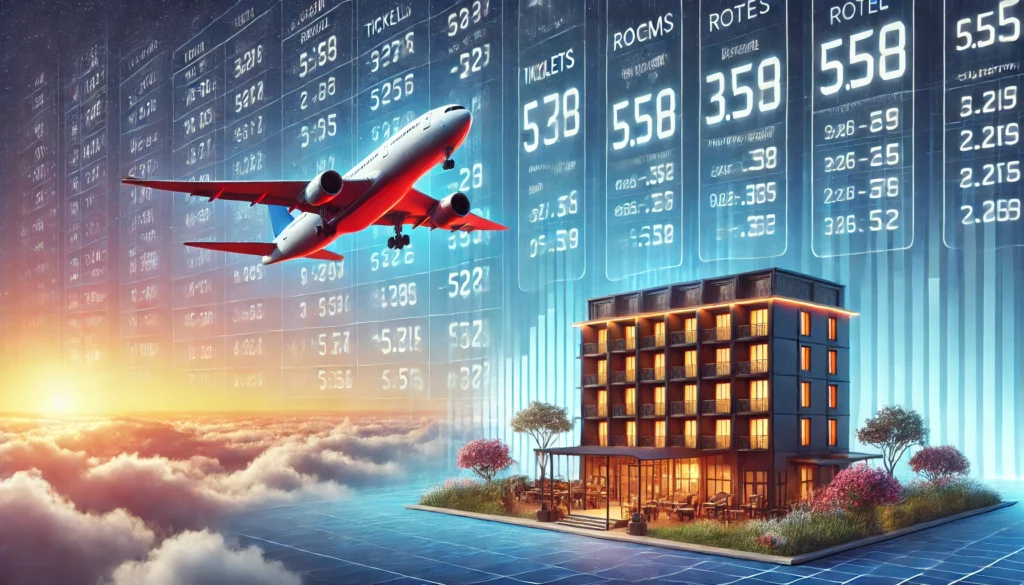Pricing in Hotels vs Airlines

How Amazon and Airlines Like American and Lufthansa Price Their Products—and Why It’s Never Manual
Have you ever wondered why the price of an airline ticket changes between breakfast and lunch? Or why Amazon’s deals seem perfectly timed to your needs? It’s not magic—it’s data. Companies like Amazon, American Airlines, and Lufthansa use highly sophisticated algorithms to price their products in ways that would be impossible to manage manually.
In today’s hyper-competitive markets, manual pricing isn’t just inefficient—it’s downright unthinkable. Here’s why.
The Impossible Scale of Manual Pricing
Amazon has over 12 million products in its marketplace, not counting third-party sellers. Airlines, on the other hand, juggle thousands of routes, each influenced by demand, seasonality, and competitor activity. Setting prices manually for even a fraction of these would require an army of analysts working around the clock.
Take airline pricing, for example. Every flight has a finite number of seats, and every unsold seat is lost revenue. Airlines rely on dynamic pricing to ensure that planes fly as full as possible while maximizing ticket revenue. It’s not uncommon for the same seat to sell for vastly different prices depending on when and how it’s booked.
Manual systems simply can’t keep up with this complexity. Even the fastest human would take hours to set prices that an algorithm adjusts in milliseconds.
Why Automation Wins Every Time
1. Real-Time Precision
Algorithms process billions of data points in real time, from competitor prices to weather patterns. For example, Lufthansa uses AI to predict when travelers are most likely to book flights and adjusts prices accordingly. This ensures that no opportunity for revenue optimization is missed.
2. Demand Forecasting
AI doesn’t just react—it anticipates. Using historical data and market trends, it predicts future demand and adjusts prices proactively. American Airlines, for instance, pioneered yield management systems that balance ticket prices and seat availability to maximize revenue on every flight.
3. Personalization at Scale
Amazon’s pricing engine is infamous for its ability to tailor deals to individual users. Based on your browsing history, purchase patterns, and even geographic location, Amazon offers prices that feel “just right” to you. This kind of personalization would be impossible without automation.
Case Studies: Automation in Action
Amazon’s Dynamic Pricing Machine
Amazon adjusts prices on products an estimated 2.5 million times a day, with changes happening as frequently as every 10 minutes. This ensures that they remain competitive while maximizing profit margins. In 2022 alone, this strategy contributed to Amazon’s $469.8 billion revenue (Statista).
Airline Revenue Boosts
Lufthansa’s AI-driven pricing system helped the airline achieve a 5% revenue increase by optimizing ticket prices during peak and off-peak times. Meanwhile, American Airlines’ automated system has been credited with saving the company millions by filling seats that would have otherwise gone unsold.
The Madness of Manual Pricing
Let’s imagine a world where pricing was still done by hand. Amazon would need tens of thousands of employees just to keep prices updated, and even then, they’d be slower than competitors using automation. Airlines would hemorrhage money as analysts struggled to account for fluctuating demand and competitor actions. In short, manual pricing would be a death sentence for modern businesses.
The Future: Smarter, Faster, Fairer
Automation doesn’t just make pricing more efficient; it makes it better for everyone. Consumers get fairer, more transparent prices tailored to their needs, while businesses maximize revenue without wasting resources. The next frontier? Hyper-personalization, where prices adjust not just for the market but for the individual.
Manual pricing isn’t just outdated—it’s unimaginable. Companies like Amazon and Lufthansa show us what’s possible when data and technology work hand in hand. The question isn’t why businesses use AI for pricing; it’s why anyone would still consider doing it manually.
